Blog  Natural Wanders in Australia (Wildlife Encounters & Where to Find Wildlife)
Natural Wanders in Australia (Wildlife Encounters & Where to Find Wildlife)
Red-tailed Tropicbird, Lord Howe Island, New South Wales, Australia. © Steven David Miller
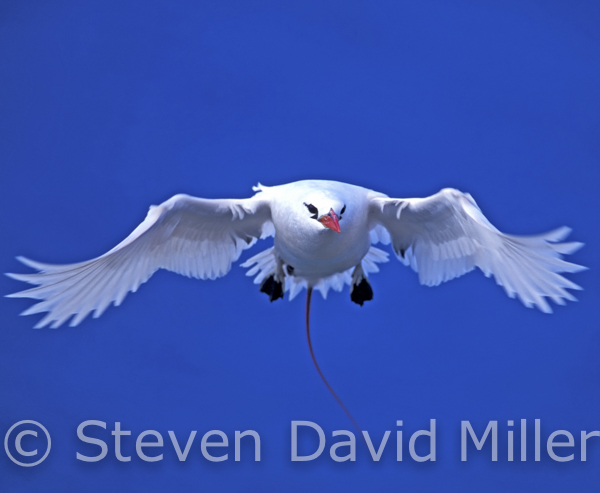
Tropicbird Encounters
One of the many natural wonders of Australia’s Lord Howe Island is the red-tailed tropicbird. These birds nest along the edges of Malabar Cliff that are accessed via a heart-pumping 7km climb up Malabar “Hill” to Kims Lookout. From here, sure-footed walkers can venture along an upper ledge to find females sitting with chicks or fledglings. Up above, tropicbirds are soaring gleefully in the updraft, making little barking calls to each other. It is hard to come to any other conclusion than they are flying for the fun of it (as any human pilot can testify to). Mating tropicbirds engage in airborne courtship with each bird taking a turn to soar up above its mate and then flutter backward until it is behind its beloved, and then the mate does the same again—a sort of aerial game of leapfrog in reverse.
Another great place on Lord Howe to watch tropicbirds in flight is at the top of Mount Eliza. You’ll have to walk or catch a boat over to North Bay and then climb to the summit of Mount Eliza (an easier climb than Malabar Hill). From here you have a spectacular view of Mount Gower and Mount Lidgebird at the southern end of the island. Below, the cliff walls drop straight down to the ocean creating those updrafts that tropicbirds enjoy so much. You can also watch out for nesting sooty terns here (in fact, the track is sometimes closed when the terns are in peak nesting season). Don’t just watch the birds up above though, glance down and you might be lucky enough to spot dolphins swimming below.
*For more information on Lord Howe Island please see our Natural Wanders in Australia (Destinations) Blog posting of February 23rd, 2015.
*Another great place to find nesting red-tailed tropicbirds is on the Great Barrier Reef’s Lady Elliot Island. Look for them under the low shrubs growing near the shoreline down from the resort.
© Linda Lee Rathbun
Emus at Cape Range National Park, Western Australia; Emu at Coffin Bay National Park, South Australia. © Steven David Miller
|
|
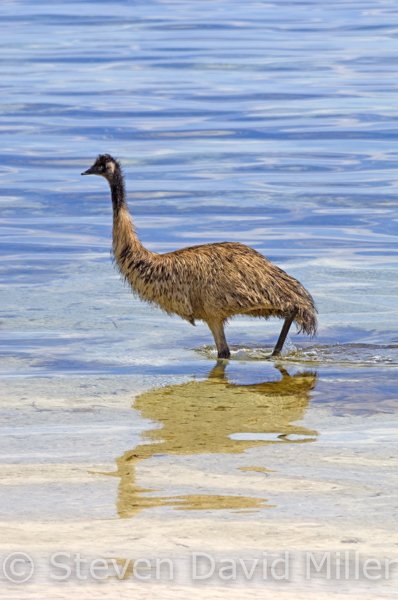 |
The Engaging Emu
We found this trio of young emus near a bore water tap in Western Australia’s Cape Range National Park (near Exmouth). As various campers would arrive to fill their containers, a small puddle of water would gather under the tap. As soon as the campers left, the emus moved in to drink from the puddle and to lap up any faucet drips. These three siblings’ father stood guard nearby, partaking of the water source as well. Female emus leave all parenting chores up to the fathers; once a female has laid her eggs she simply walks away while the father sits on the eggs and cares for the chicks until the next brood comes along. At the bore water tap in Cape Range, we noticed a number of fathers with chicks at various stages of growth. We returned there over several mornings and did not hesitate to make sure there was plenty of water for the emus--campers had left used tubs of ice cream and so on as containers for these massive and captivating birds and we always filled these before leaving. (Water taps are always a good place to look out for wildlife.)
Emus are all over the place in the Cape Range area, even walking around ‘downtown’ Exmouth. They have no road sense whatsoever: we have slowed down for them when they are walking beside a road, then sped up a tiny bit when they appear to veer away from the vehicle only to have them turn quickly and dash in front of the car. One of our fondest memories is of a long-ago visit to an emu farm in Tasmania where, I swear to God, a band of emus started playing footie with a tennis ball that the farm owner had thrown onto the ground for them: it was hilarious. This same owner could stretch his arms out and one particular emu would rush up to him for a hug. Personally, I don’t see how you could turn these birds into emu steaks and emu oil after watching their antics that are so full of life and fun.
Emus enjoy going for a swim, and while we didn’t see any doing this at Cape Range, we did at Coffin Bay National Park in South Australia. Along gorgeous Coffin Bay, where protected waters can be as still as a sheet of blue ice, we found emus wading just off the beach, presumably trying to cool off. Other great places to find emus are at Wilpenna Pound in Flinders Ranges National Park and at Mungo National Park in New South Wales. Many other Australian places are home to this wonderful, flightless bird.
© Linda Lee Rathbun
*For information on Coffin Bay National Park and Flinders Ranges National Park please see our Natural Wanders 4WD Australia Blog.
Australian Sea Lion Pup, Seal Bay Conservation Park, Kangaroo Island, South Australia.© Steven David Miller
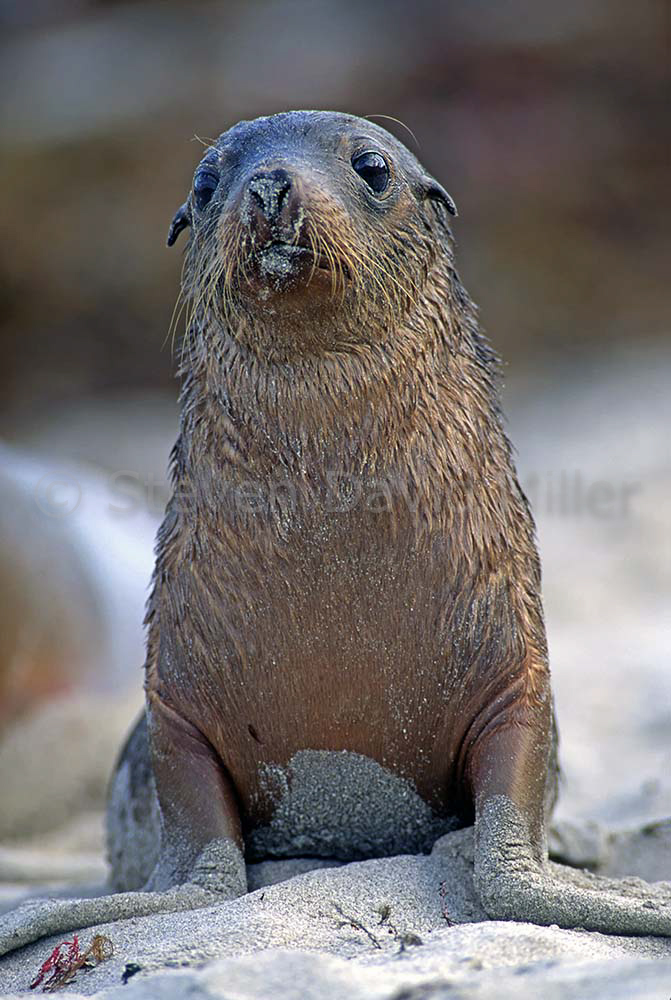
Encounters with Fur Seals
Many years ago (actually, more decades ago than I care to admit to) we took a trip out to Kangaroo Island in South Australia and had a wander along a beach inhabited by a huge colony of Australian fur seals. The seals were vulnerable to human disturbance and intrusion, and so the bay where they live came under the management of the state government. Today, Seal Bay Conservation Park protects these fascinating marine mammals while allowing controlled access so that visitors, in small, guided groups, can see the fur seals up close without intruding on the seal’s normal behaviours and life.
On a more recent visit to Kangaroo Island, we returned to Seal Bay and did a late afternoon tour with a most informative and helpful guide. Huge males, smaller females, and young seal pups were spread across a long stretch of beach. The males were mostly looking for fights with other males and/or trying to dominate the females. The females were sunning or napping together in small groups, some with young pups to care for. One youngster made its way down a sand dune near the boardwalk, only to scramble back up the hill after spotting an adult male nearby. Our guide explained that these males posed the greatest threat to young seals. As if to illustrate the guide’s point, a female seal further up the beach wanted to bring her pup closer to the middle, but didn’t want to venture past a grumpy male. With gentle and patient coaxing, the mum finally persuaded the pup to follow her into the shallow water where they swam a safe distance to where the mother felt it was safe to venture back up onto the beach. We stood as close to the mum and pup as the guide allowed us to; the pup watched us with curious, beautiful brown eyes; the mother gazed at her baby with love and tenderness (so sue me for being anthropomorphic).
Seal Bay Conservation Park is not-to-be-missed. You can experience it on your own using the extensive boardwalk, and/or you can take a guided tour. This is well worth the money and is an experience you won’t soon forget.
For us, the day ended with the sun melting into the horizon while seals surfed the breaking waves on the last light of day. Don’t miss this sensational place.
© Linda Lee Rathbun
*For more information visit http://www.environment.sa.gov.au/sealbay/Home. Another place to see both Australian and New Zealand Fur Seals on Kangaroo Island is near Admirals Arch at Flinders Chase National Park.
Spinifex Pigeon, Purnululu National Park, Western Australia. © Steven David Miller
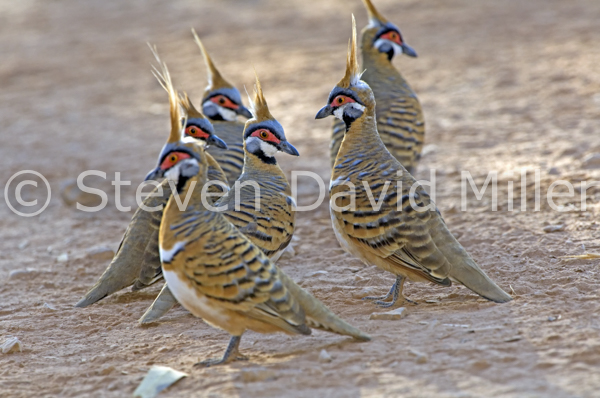
The Skitterish Spinifex Pigeon
Water is scarce in Western Australia’s Purnululu National Park. Toward the end of the dry season, a number of bird species rely on the water taps in the Walardi and Kurrajong campgrounds, and this makes for an excellent opportunity to do some bird watching and photography. Once, while watching finches and honeyeaters in the branches, we were joined but a small platoon of spinifex pigeons. This has to be the most tightly-wound bird species imaginable, marching around with facial colouring and feathered crests that look like a WWI European ceremonial helmet. We sat quietly, trying not to laugh out loud as one bird would build up the courage to approach a small puddle under the tap, then scurry off in fright, then approach, then scurry, then approach, then retreat altogether while another bird took up the challenge to approach, then retreat, then approach...well, you get the idea. This went on for several minutes until one brave soul mustered all of his courage and dashed in for a drink, swiftly followed by the rest of his mob that clustered around the puddle nervously sipping at the water. An unheard sound alarmed them and they fled in every direction, and the cycle began again. We left, not wanting to disturb them or deprive them of the chance to drink from this precious source of water in the Bungle Bungle Ranges of Purnululu. Forever after, I am delighted when I find a spinifex pigeon, and I always stay to watch the show.
© Linda Lee Rathbun
*Water sources are always great places to find wildlife, especially in arid areas. At Purnululu, check the water taps at the campgrounds and also the two private safari camps at the Bellburn end of the park. In these places, we have found spinifex pigeons, a variety of finch species, and honeyeaters among others.
Masked Lapwing Chick, Hervey Bay, Queensland, Australia. © Steven David Miller
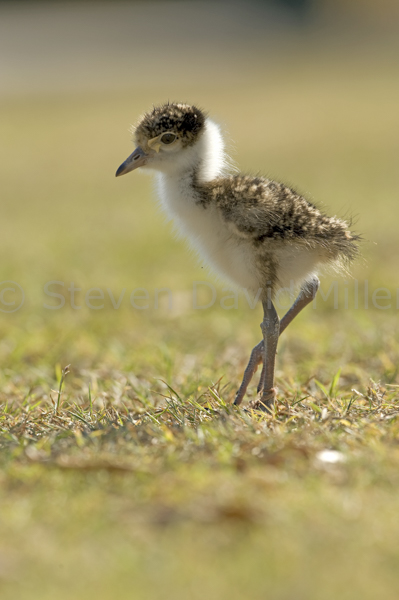
Saved by a Digital Picture
This masked lapwing chick lived near our campsite at the Hervey Bay Caravan Park, and we enjoyed watching him strut about while his parents also watched from nearby. We, and other guests at the park, noticed that the chick was limping, and though we all tried to see what was wrong, the parents would not allow us to get close enough to examine the chick. After an inspection with binoculars, we concluded that the chick just had a sore leg, and there wasn’t much we could do without traumatizing the family.
We moved south to other places along the Great Sandy Strait, and about a week later, while editing digital pictures, we blew up the image of the lapwing chick and saw that a piece of string was wound tightly around its lower leg. Knowing that this would cause long-term damage, we emailed the picture of the chick to the owners of the caravan park who had also noticed that the chick was limping. Once we explained what the problem was, the owners armed themselves with gloves and a sharp pair of sewing scissors, and in spite of a huge fuss on the part of the lapwing parents, managed to capture the chick and carefully cut off the string. On another visit to the park many months later, we were delighted to see Steve’s picture of the chick up in the office, and we all agreed that what could have been a crippling injury for the chick, and ended in no damage at all.
© Linda Lee Rathbun
*Never leave an injured animal to suffer--there are numerous wildlife rescue services that will help if you can't. See our special posting on the Blogs homepage.
*Campgrounds are often great places to find wildlife. We have often set off on long walks hoping to find wildlife (birds in particular) only to return to our site to find the very bird we were looking for happily sitting in a tree over our campsite. At the Hervey Bay Caravan Park mentioned above, we have found lots of bird species (including the wood ducks mentioned below) and a massive camp of flying fox living in the botanical gardens next door: every evening the sky was filled with thousands of them when they would fly off at dusk in search of food.
Australian Wood Duckling, Hervey Bay, Queensland, Australia. © Steven David Miller
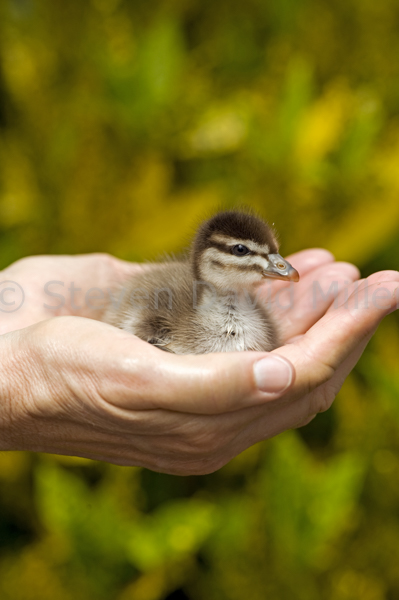
The Lost Duckling
We were camped at the Hervey Bay Caravan Park doing some whale-watching when a rainstorm hit and flooded a field nearby. Egrets, herons, and ducks converged on the new wetland, among them, a family of wood ducks. One of the ducklings was injured and could not keep up, so the father lingered behind, offering quacks of encouragement. When the duckling came to a complete standstill and would not move, the father was forced to move on with the rest of his family. We were watching and intervened when it seemed that the duckling could not even stand. After placing him in a small box for safety, we called a number of vets and finally found one who had time to see our little patient (vets in Australia will treat injured native wildlife for free). Several hours later, and a few minutes before we were ready to leave for the vet’s, our little guy hopped out of his box and started protesting loudly at his confinement. We could see that he had recovered from his injury as he scampered around the inside of our van. So, the search was on to find his family; we scoured the wet field and the campground, asking owners of onsite vans if they had seen a wood duck family. We finally found the right entourage, and as we placed the duckling on the ground, the father rushed over, loudly reprimanding us for kidnapping one of his children. The mother, standing by the siblings, quacked softly, welcoming back her lost child. It was a very happy reunion indeed. We weren’t sure if we had done the right thing, but we took comfort in the notion that all’s well that ends well.
© Linda Lee Rathbun
Australian Giant Cuttlefish, Whyalla, South Australia. © Steven David Miller
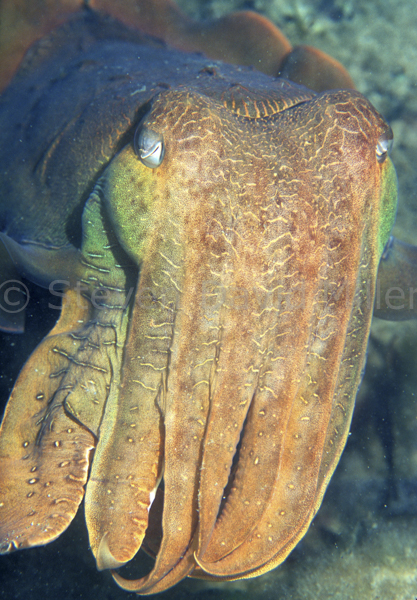
The Whyalla Aggregation
The seaweed in False Bay is swaying, and some of it has eyes. A squashed football torpedos forward, trailing a bundle of flowing arms. Just as quickly, the football reverses at full throttle, sucking water into a mantle and jetting it out through a swiveling funnel, revealing that it--and the seaweed--are really Australian giant cuttlefish. One of them settles on a patch of sand and turns from prickly brown to a smooth opal, blending with the bottom. Another cuttlefish waltzes gracefully by fluttering lateral fins--one moment a golden skirt of shimmering gossamer, the next a pulsating red flamenco dress edged with white.
Above the surface, Whyalla fans out around the bay. To the west is the BHP Jetty where a portion of the annual output of over one million tonnes of steel is shipped. To the east is the Port Bonython Jetty where LPG and crude oil are loaded onto marine tankers for export. A straight line between the two jetties encloses False Bay in a semicircle where tens of thousands of cuttlefish mate and spawn in the largest known aggregation of cephalopods on the planet.
The “Whyalla Aggregation” has gained fame among cephalopod scientists, documentary filmmakers, and divers from around the world. Like a voyeur, you dive five meters under the water’s surface to observe the cuttlefish dashing about like animated kaleidoscopes on amphetamines. You notice a large specimen with a decorative ruffle along its outer arms: a male looking for love. He hovers above a smaller female, keeping her from the bevy of males anxious to mate with her. He zooms over to an approaching rival and they engorge themselves to appear bigger, fluttering and waving their bannered arms. An intense pyrotechnic duel follows as each pulsates jeweled red and white stripes across its body and arms.
The female pays no attention to this brouhaha, instead inspecting a rock as a suitable site to attach an egg. The victorious male returns to her side and she signals him with a wave of reflected, dappled white light along her arms. They face each other like tango dancers swaying to the rhythm of the sea. The male grabs her in a headlock and suddenly their arms tangle as they cling to each other. Their tango finishes and he resumes his guard post. A small male approaches, morphing into the shape and color of a female. The guard lets him past, thinking that now there are two females requiring his protection. When a large male swims up and engages the guard in Technicolor fisticuffs, the female impersonator seizes the moment and mates with the female. The guard is so busy that he does not notice he has been made a cuckold.
It is just that sort of shocking behaviour that makes the Whyalla Aggregation such a delight to dive with.
© Linda Lee Rathbun
*For information on diving with cuttlefish in Whyalla, visit www.whyalla.sa.gov.au and navigate to Tourism & Leisure then Attractions then Cuttlefish. Also, check www.whyallacuttlefish.com-.
The cuttlefish season is May through August. You can go out with a dive operator, or snorkel on your own; check the websites mentioned above for more information.
Goliath Stick Insect, Northern Territory, Australia. © Steven David Miller
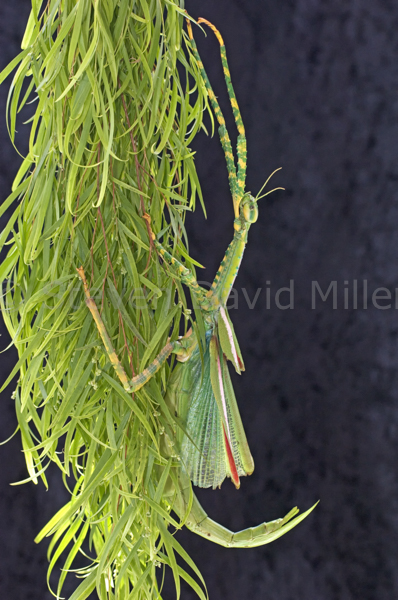
All About Barkly
A “controlled” fire raged beside the Barkly Highway. Kites soared above, watching for small marsupials escaping from the flames and smoke, then swooping down to catch their terrified prey. Insects swarmed from the safety of homes tediously constructed of mud and saliva then incinerated by man’s slow burn. Ahead of us, a flash of iridescent green, so bright in the surrounding black and grey cinders, alighted on the tarmac. Steve brought the car to a quick stop, pulling over on the rusty-coloured dirt of the shoulder. The green creature moved along the road, like a pencil on a slow roll. Steve leaped from the car and ran back, carefully lifting the green stick, bringing her to me. She snapped her wings in alarm, opening them to reveal a flash of scarlet like a flowing flamenco skirt. Her six legs were striped with lemon yellow as she waved them in defense. She watched me, wary of the monsters that had plucked her from the ground. She was a goliath stick insect, and we named her Barkly.
The Barkly Hwy went on and on, crossing from the Northern Territory into Queensland. Our Barkly climbed up my arm, the tiny spurs on her six feet allowing her to cling safely to my shirt. She seemed content as we drove through Camooweal, finally stopping in Mount Isa for the night. Internet access allowed us to do some research on goliath stick insects: they needed water and fresh eucalyptus leaves. We left Barkly in the caravan where she attached herself to the screen on a window. When we returned with clusters of leaves, pegging them to the curtain, she climbed right into them. We sprayed water on the leaves and she drank, turning her amazing yellow head striped with green to look at us. That night, I moved her into the van’s small bathroom for safety. She cracked her wings at me, horrified by my touch, then gratefully climbed onto the towel we hung up for her.
Now the landscape held a new interest for us. Instead of gazing out the window admiring the scenery and looking out for flocks of parrots, we began to watch for eucalyptus trees with fresh sprouts. For hundreds of kilometres along the Barkly, we kept a sharp eye out, stopping at rest areas to gather leaves whenever possible. During the day, Barkly stayed in the car with us, wandering along the padded ceiling and quickly finding her leaves when hungry. From time to time, she would sit on my shoulder or climb onto my head. When we were at camp, she would stay in the caravan; she learned that when I moved her into the bathroom at night she had nothing to fear, and her defense displays stopped. We were always looking for a suitable place to release her along the Barkly which became the Flinders Hwy then the Cook Hwy all the way up to Cooktown: over a thousand kilometres from her home. We couldn’t let her go though, she had become a part of the family.
Over a month later, Steve, Barkly, and I returned to Townsville and ventured inland again. Barkly had started to lay eggs. Female goliaths can clone themselves through parthenogenesis, and Barkly’s eggs were everywhere, like small black BBs she shot from her abdomen. We began to collect them: future Barklys all over the place. In Longreach, we camped beside a couple with a young daughter, Monet. Monet came to our van daily to visit Barkly, drawing pictures of her for us (Steve loves to say he has a drawing by Monet). We gave Monet twenty of so of Barkly’s eggs, and she promised to email us if any new Barklys were born.
Barkly died one night in Bundaberg. We buried her beneath a palm tree with leaves as bright and green as she was. She had been with us for almost three months, and we missed her. We kept her eggs, but the baby Barklys never hatched.
Back in Melbourne, a few months later, we received an email from Monet’s parents. The container with Barkly’s eggs had spilled behind the kitchen cupboard where they kept their coffee maker. One morning they woke to find a bright green phasmid sitting on the coffee maker, a perfect mini-Barkly. More Barklys emerged over the next few days. Monet took them to school and her teacher began a project called Fascinating Phasmids; the project spread to other classrooms. The baby Barklys lived in large screen cages and were fed by enraptured students delighted by the iridescent green, yellow, and scarlet creatures. Barkly’s babies began to lay eggs, and so the cycle of life continued. We had rescued many animals in our travels around Australia, but Barkly was special.
© Linda Lee Rathbun
*If you spy a green stick trying to cross a road, please pull over if it is safe to do so; the stick may very well be a goliath stick insect. Gently move it off the road in the direction it was heading in, preferably to a leafy tree or shrub where it will blend in. A good way to find stick insects, mantids and so on is to look at the bark of trees, on green leaves, on shrubs, etc. Soon you will train your eyes and it will be easier to find all sorts of wildlife.
White-lipped Green Tree Frog, North Queensland, Australia. © Steven David Miller
A Frog on a Tire
This is "our" green tree frog rescue; we discovered this fellow sleeping on the front tyre of a vehicle at a parking lot in Cairns, Queensland. Knowing that the frog would not survive a ride, and without a safe place to move him to, we decided to take him back to our caravan park. With lush vegetation all around, it wasn't hard to find a palm to place him on. Steve took a number of pictures, which we later used for a Christmas card since the colours were so perfect, and after the 'shoot' we found him a safe and suitable hiding place. While we normally have a policy of never removing an animal from the place where we found him, or at the very least returning him there, in this case, we did not feel that the frog would survive his siesta on a tyre. We hope he enjoyed his new home, and we fondly remember this magnificent amphibian whenever we see this picture. The white-lipped green tree frog is the largest species of tree frog and is endemic to the Cape York (far North Queensland) region.
*The best place to find tree frogs in the Cairns, Queensland area is at night under lights where it is wet; when camping, the shower blocks are likely places. In fact, I have taken some of my best showers with frogs sitting happily on a window sill above the showerhead. Also, look in the tanks of toilets and the drain hole of sinks.
© Linda Lee Rathbun
Perentie, Point Quobba, W.A. © Steven David Miller
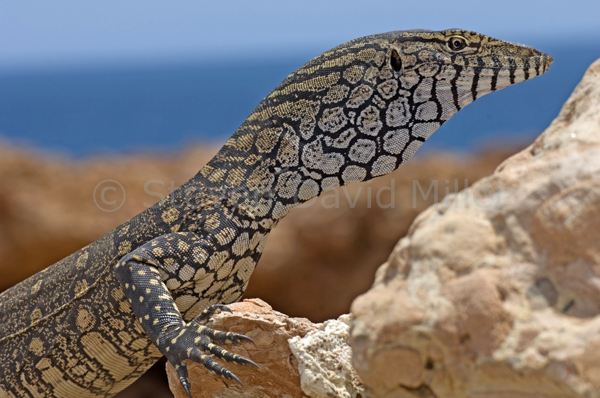
A Perentie Goes Fishing
We found this magnificent perentie, measuring about 3' in length, sunning himself on a rocky outcrop near the blowholes at Point Quobba in Western Australia. As the tide dropped, he seemed to gather energy, and after a while, he headed off in a very deliberate direction closer to the waterline. He began to investigate the tidal pools, and we quickly realized that he was searching for fish caught in pools on the low tide. He ignored us and we were able to follow him from pool to pool, taking photos as we went. I always think we underestimate animals, and a reptile who plans his meals around the tides is surely showing a number of skills that are worthy of admiration.
*Point Quobba is well worth a visit if you happen to be passing through the coastal town of Carnarvon. Head NE on the Coastal (1) Highway and then W on Blow Holes Road. Watch for other lizards sunning themselves on the tarmac as it would be a shame to run over any of Australia's magnificent reptiles.
© Linda Lee Rathbun